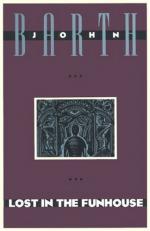|
This section contains 9,794 words (approx. 33 pages at 300 words per page) |

|
SOURCE: "Water-Message," in John Barth, Twayne Publishers, 1986, pp. 84-109.
In the following excerpt, Walkiewicz maintains that the Möbius strip "Frame-Tale," which opens Lost in the Funhouse, serves as an analogy for the entire collection, which cycles back to its beginning in the final story, "Anonymiad."
[The] structure of Lost in the Funhouse, we are led to believe, is a closed loop. Its "Frame-Tale" is a kit for constructing a Moebius strip which the reader is free to regard as "one-, two-, or three-dimensional." Once it is completed mentally or physically, the loop becomes an emblem of the "Law of Cyclology" and all its corollaries, including the propositions that make up the "monomyth." As a continuous tape, it not only reminds us of the Grand Tutor's "endless tapes" but also suggests the means of presentation of many of the pieces in the book, and it is thus emblematic...
|
This section contains 9,794 words (approx. 33 pages at 300 words per page) |

|


